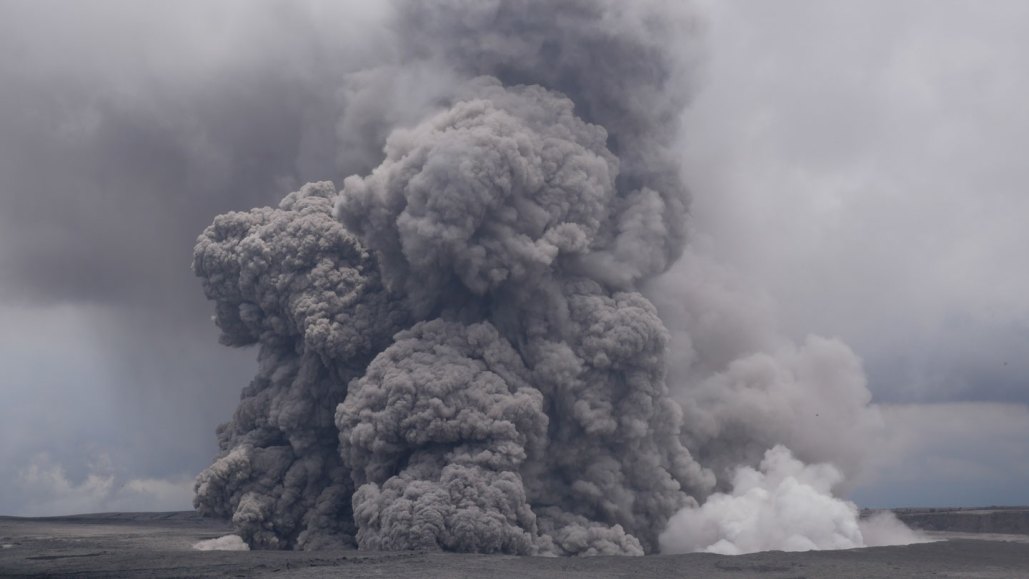"Hawaii's Kilauea Volcano Erupted with Explosive Force in 2018"

In 2018, the eruption of the Hawaiian volcano Kilauea may have been due to an unprecedented style of eruption, which resembles the operation of a stomp rocket toy.
During May of that year, up to eight kilometers high, columns of hot gas and rock violently erupted in 12 successive bursts. According to a study published on May 27 in Nature Geoscience, the continuous falling of the Kilauea’s summit crater or caldera led to these forceful eruptions.
The team of researchers explained the process. Whenever a substantial chunk of the crater rock dropped into the magma chamber, air in the chamber compressed abruptly, sending volcanic fragments soaring high into the sky. This process is similar to the launch of a stomp rocket toy upon forceful compression of its air bladder.
Joshua Crozier, a Stanford University geophysicist, explains that usually, volatile volcanic eruptions arise from two familiar mechanisms. One involves the release of gas bubbles due to the depressurization of magma upon rising, resulting in the stunning display of exploding molten rock. The other mechanism involves the rapid heating of groundwater by an ascending magma plume, resulting in sprays of steam and shattered rock.
However, these two mechanisms did not quite explain the events that unfolded at Kilauea from the 16th to 27th May 2018. According to geophysical data collected at the peak of the volcano during the eruption, neither of these were responsible for the unusual, repetitive eruption sequence, says Crozier.
Crozier highlighted two factors that ruled out the mechanisms mentioned above. The magma ejected lacked foam-like magma bits that would have been expected in the first scenario. Furthermore, the caldera rocks were too hot to contain any considerable amount of water that could be superheated, making the second scenario unlikely.
Crozier and his team thought the caldera's incessant collapses since mid-May might explain these eruptions. To test this, they assessed data collected at Kilauea, one of the world's most intrusively observed volcanos.
Seismometers closely monitor the volcano's activities, tiltmeters equipped with GPS near the summit detect minor changes in ground movement and tilt, observing strain alterations as a result of magma movements. Hawaii Volcano Observatory also has an infrastructure of infrasound arrays to track atmospheric pressure changes caused by events such as explosions.
Changes in the frequency of infrasound waves traversing the ground unveiled a pattern during this brief period. The chamber seemed to expand, followed by an explosion. At the same time, the seismic data revealed distinct earthquakes corresponding to these events, all less than a magnitude of 5.
The researchers have interpreted that the magma chamber likely drained sufficiently to destabilize the caldera roof above it, causing it to fall due to its own weight. This decreased the reservoir's volume, akin to compressing a stomp rocket's air bladder. A view of the eruptive plumes through cameras around 10 to 30 seconds after suggested the collapsing roof had shot up hot gas and rock debris, due to air pressurization in the chamber.
Larry Mastin, a volcanologist at the U.S. Geological Survey’s Cascades Volcano Observatory, not involved in the new study, said such a mechanism has never been proposed to guide eruptions up to his knowledge. He stated that the occurrence was quite unique but fits the unusual circumstances of this eruption. Mastin also adds that these rare observations helped to narrow down the cause of these eruptions.
According to Mastin, the stomp rocket mechanism was only useful in the early stages of Kilauea's caldera collapse when it directly plummeted on the magma body. As the caldera floor's collapse spread outwards over time, the stomp rocket compression ceased at Kilauea. In the meanwhile, the vent in the central caldera became clogged with material, stopping eruptions at the summit.
Crozier believes that Kilauea isn't the only volcano that could have experienced stomp rocket-style eruptions. However, Kilauea’s comprehensive surveillance system made detecting and defining this new phenomenon possible. Knowing how to associate the seismic and infrasound data can lead to better hazard mitigation strategies for other less well-equipped volcanos in future, Crozier says.
“In many cases, the first sign we have of an eruption is a seismic or infrasound signal. So if we can get better at relating those types of geophysical data to what the eruptive plume is doing, the better we can calibrate our models,” he says. That would reduce hazards to aviation as well as communities.




